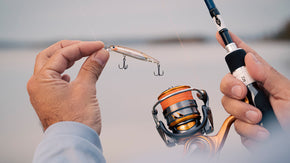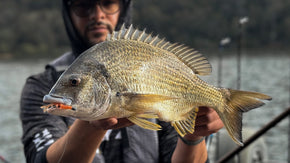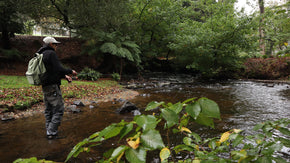Posted 30th June 2023
How to Set-Up a Soft Plastics Outfit
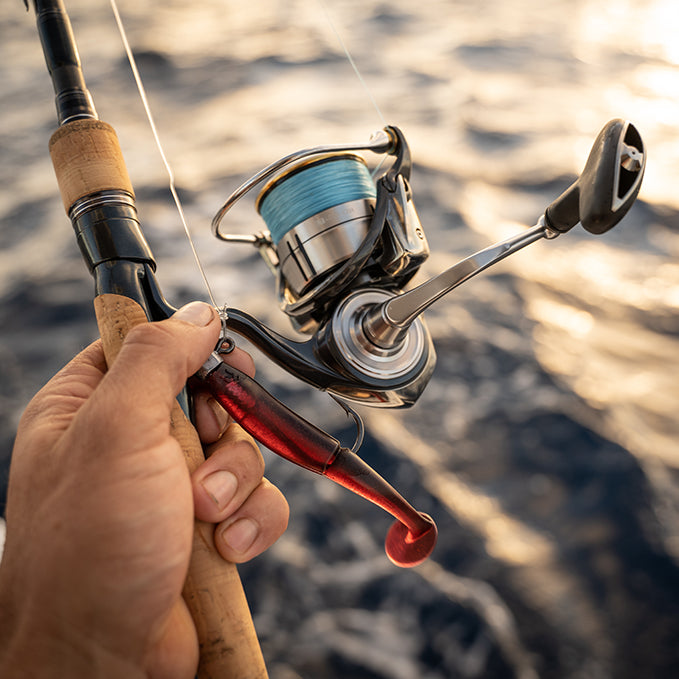
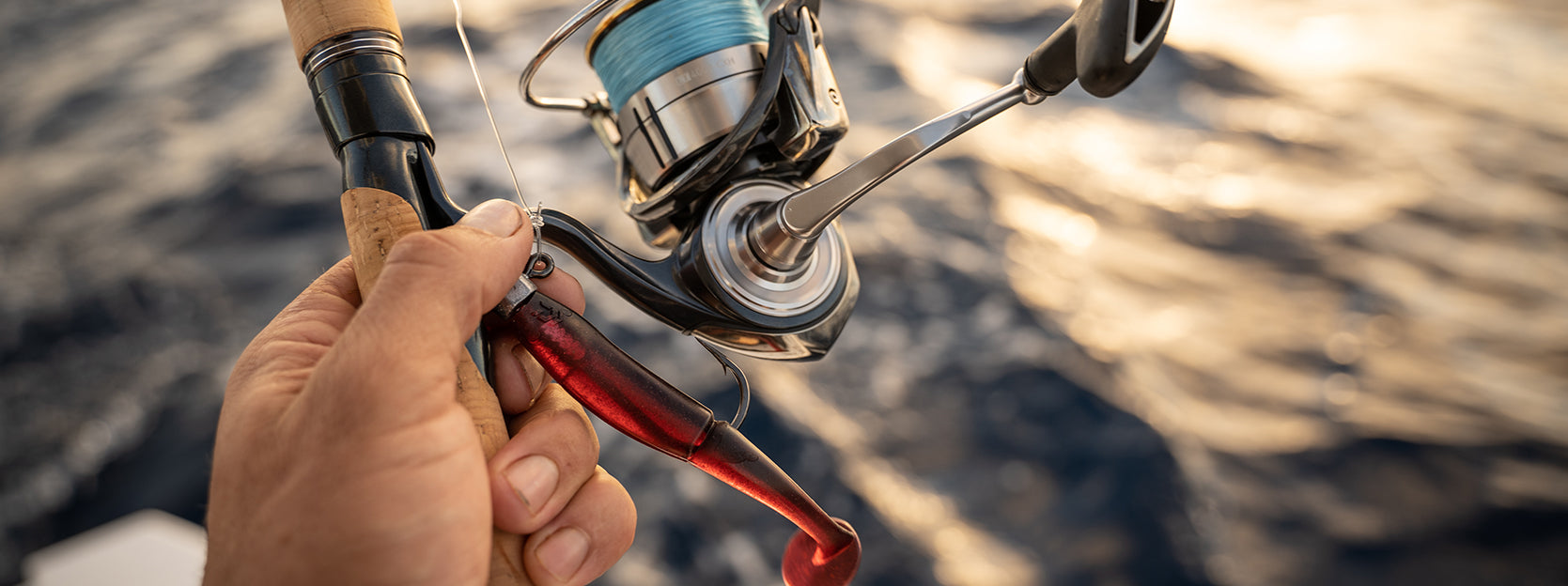
By Robert Thornton
For many avid sport fishers, there was a time in their angling journey when they decided to switch from bait over to lures. In the past few decades, soft plastics have become a popular jumping-off point for anyone wanting to do just that. With so much information and product out there though, this process can become a little overwhelming and confusing.
In this blog we’ll go into why soft plastics are such a great tool for learning how to fish with lures, and how specific tackle selection can help you get the most out of them. After that, we’ll look at a few different rod, reel and line set-ups to suit different budgets, and hopefully get you started on your soft plastic kick.

Why Has the World Gone Soft?
Soft plastics have been a part of the Australian fishing scene for 40 years or so, with the past 20 years seeing the most rapid changes in this space. For a more detailed explanation of soft plastics and their history, you can check out my blog on using soft plastics in saltwater.
From the point of view of someone switching from bait to lures, fishing with soft plastics is a great way to learn about lures because of how bait-like they are. A 2-3” soft plastic rigged on a jighead isn’t too different from a yabby threaded onto hook with a running ball sinker above it.
Soft plastics allow anglers to easily imitate a lot of popular baits, such as yabbies, worms and small fish. Hardbodied lures also allow anglers to do this, however because of how natural soft plastics feel, fish will tend to hang on to them longer once they grab them, giving the angler a few ‘extra chances’ at hooking that fish.
Soft plastics additionally offer the user the option of using scent to enhance their appeal – some even have scent built in! The soft body material lets the scent soak in and disperse slower than it would with a hardbody. Many soft plastics are even built with extra ribbing and other appendages that are designed to hold scents for longer.
Finally, soft plastics allow anglers to easily adjust their approach to suit changing conditions. For example, an observant bait soaker would slide a heavier sinker onto their rig if the current speed picked up a little. In the same situation, a lure angler could rig their soft plastic on a heavier jighead and keep themselves in the game without having to change their presentation too much.

Soft Plastic Tackle
The similarities between bait and soft plastics are many, however where they differ is in the tackle used to present them. Let’s take a look at why soft plastics work best with specific tackle.
Light bait fishing set-ups usually involve wobbly-actioned fibreglass rods and monofilament as mainline. This is to allow fish to bite the bait and get it into their mouth without feeling too much resistance. The extra give that the fibreglass and monofilament allow means the angler can watch the rod load up and know a fish is on the end of their rig before the fish even knows what’s going on.
On the other hand, soft plastic set-ups tend to utilise stiffer graphite rods, spin reels with a smooth drag, a braided mainline and short fluorocarbon or monofilament leader. The faster-actioned graphite paired with braided mainline plays an important role with soft plastics. Firstly, it allows the anglers to easily impart action in the soft plastics with even the smallest movement of the rod – something that would be much more difficult with a sloppy fibreglass rod.
Secondly, the highly sensitive graphite and low-stretch properties of the braided line allow the angler to feel everything that’s happening through the rod. Lure fishing is about feeling the bite rather than seeing it.
Thirdly, a system with less give is useful when setting the hook. Given that soft plastics are animated by the angler and imitate something that is alive, fish will tend to commit to eating them more readily, rather than playing around or ‘picking’ at them. When a bite is registered through a graphite rod, it’s easier to apply pressure quickly to set the hook into the fish’s mouth.
Lastly, a graphite and braid set-up allows for greater casting distance and accuracy, meaning its easier to put the soft plastic where you want it, which is important when lure fishing. With most lure fishing, the idea is for you to present the rig to the fish, rather than waiting for the fish to come to the rig.
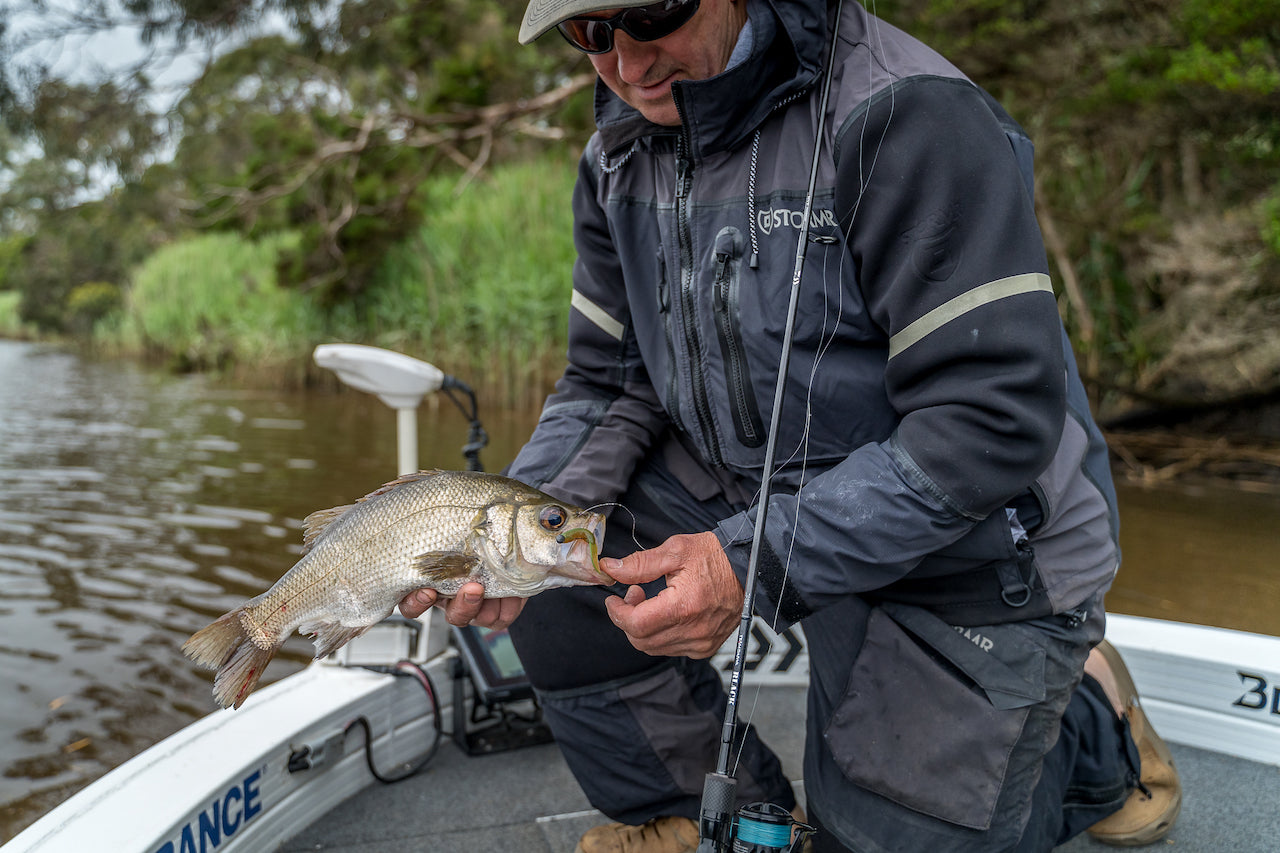
Soft Plastic Set-up Options
So now it’s time for you to put together your own soft plastic outfit, so let’s look at a few options to suit different budgets.
There are options for the budget conscious angler, and it’s very possible to build a light soft plastic set-up (rod, reel and mainline) for around the $150 mark to suit most light tackle situations. If this is you, it’s hard to go past a Laguna rod and Laguna LT spin reel. The 701MLXS model spin rod, with its sensitive graphite composite blank, paired with a 2500 Laguna spin reel is the perfect entry level combo for anyone looking to chase light tackle freshwater and estuary species. Spooled up with a 6-10lb braided mainline like J-Braid 8, this set-up is ideal for anyone looking to dip their tow into the soft plastics pool and see if it's for them.
If you’re looking for a crisper rod blank, more robust componentry and a more sensitive and smooth feel overall, it’s only a very small jump up to an Aird-X rod and Aird LT spin reel. A 701LXS Aird-X spin rod and 2500-sized Aird LT spin reel together make a great lightweight soft plastic outfit. The weight reduction that has been achieved in the building of these rods and the lowering of the rotational mass in the reel means they are one of the most smooth, sensitive and lightweight soft plastic-ready combos available in that price range. Once again, a light braided mainline will complete the set-up, and make a deadly soft plastic combo ideally suited to an angler looking to get more serious with their lure fishing.
Moving up a step again brings us to a TD Tierra rod and Tierra LT spin reel. TD Tierra rods are built with extra features such as Fuji Fazlite guides, HVF Nanoplus graphite and a split grip to improve castability, sensitivity and overall weight – fantastic qualities for a soft plastic rod. Tierra LT spin reels are also worth the extra dosh, with Corrosion Resistant Ball Bearings and an alloy body delivering a reel that is lighter but tougher, while the Air Rotor and Long Cast ABS spool ensure the reel feels super smooth when casting and winding. The Tierra LT is a highly-regarded soft plastic reel, and used by many seasoned lure anglers. The 701MLXS rod and 2500-sized Tierra LT spin reel paired together make a highly versatile, super sensitive and comparatively lightweight soft plastic set-up. If looked after this outfit will last for years, and become an important part of your kit. Anyone looking to start using soft plastics often will find Tierra rods and reels a very worthy investment.
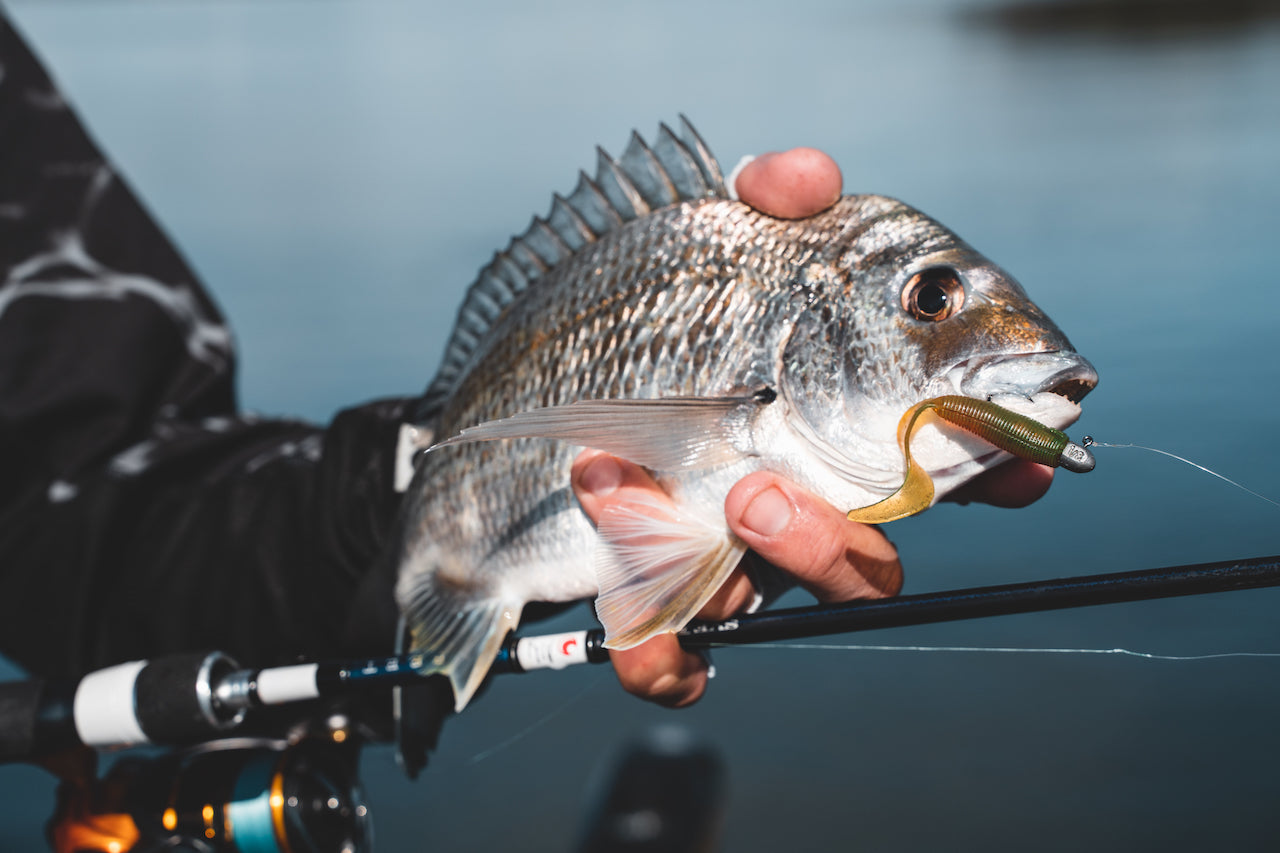
Which Soft Plastics?
These three outfits are ideally suited to throwing small, lightly weighted soft plastics for freshwater species such as bass, trout, sooty grunter, jungle perch, redfin and yellowbelly, as well as estuary species like bream, whiting, flathead, tailor, Australian salmon and small trevally. Their use is not limited to these species, however, and would also prove suitable for other small to medium-sized sportfish.
So which soft plastics should you throw on these outfits? That depends on what you’re chasing, but let’s quickly go through some soft plastic models and some appropriate applications.
The Bait Junkie 2.5 Inch Grub is a hugely versatile soft plastic, ideally matched with a 1/30-1/8oz jighead, depending on the depth and current you’re fishing in. These are a great tool when targeting the above-mentioned species when they are being a little finicky. They can be fished with a slow roll, or with a series of hops and pauses, and can also be rigged weedless for fishing close to heavy structure.
The Bait Junkie 2.5 Inch Minnowis another member of the Bait Junkie family that all lure anglers should keep a stash of. These plastics are a great allrounder, and once again 1/30-1/8oz jigheads will see these lures working at their best. These plastics can also be rigged weedless. The Minnow has less tail movement than the Grub, but the action can be enhanced with movements of the rod tip. The fish-shaped body means they are good to have tied on if you’re exploring new water, as they appeal to a huge variety of species and closely match the profile of many local forage species such as whitebait, smelt, pilchards and anchovies.
Finally, the Bait Junkie Risky Critter is another versatile creation from Daiwa, and while it can be used anywhere, it is undoubtedly at its best in the freshwater. This plastic matches the profile of a range of freshwater insects, crustaceans and other invertebrates, and appeals to species like bass, yellowbelly, trout and more. Fishing them slowly and tight to the bottom will see these lures at their optimum, with the buoyant Elastomax material helping the legs and appendages to quiver tantalisingly with the slightest movement.
With all these plastics, it’s important to run a rod length or so of light 6-12lb fluorocarbon leader such as J-Thread FC. This will add a tiny bit of stretch to the system, but more importantly, it will make the line down near the soft plastic nearly invisible to fish. Daiwa J-Braid 8 and J-Thread FC make ideal soft plastic line and leader material respectively. For tips tying a leader to your mainline, click here.
Time to Get Set!
If you’ve been wanting to enter the world of soft plastics, don’t let the saturated market and fancy jargon you see online hold you back. While there are principals that a lot of anglers stick to, these aren’t hard-and-fast rules, and your own experimentation might lead you to discover something that works better for you. Otherwise, seek the advice of the staff at your local store, and they can help you put together a soft plastic outfit that’s right for you!













